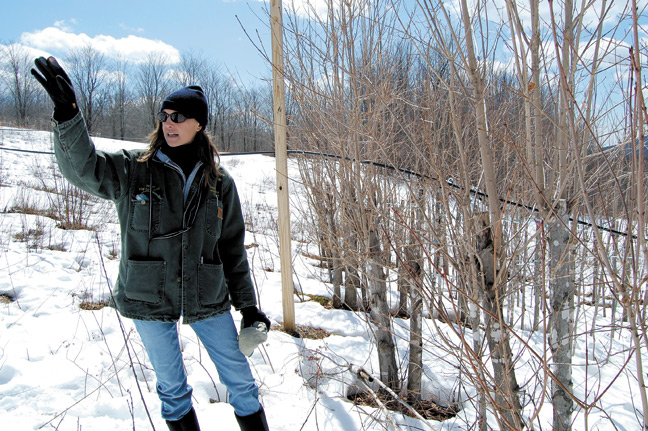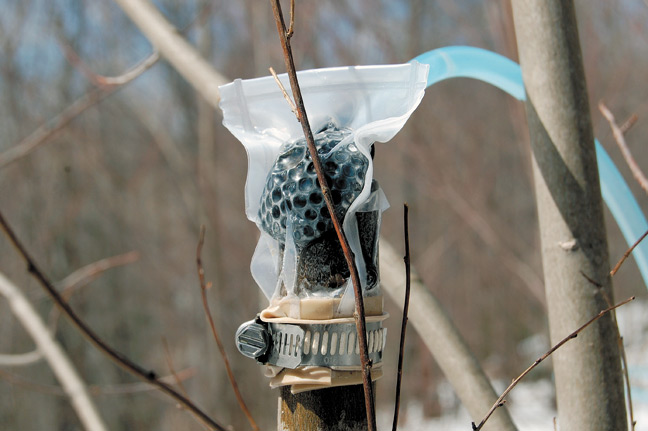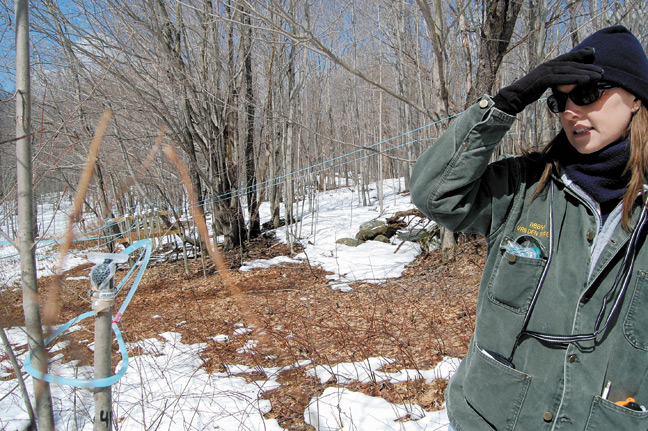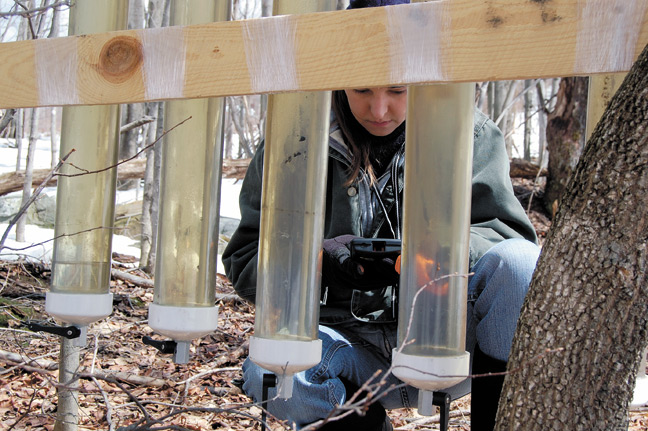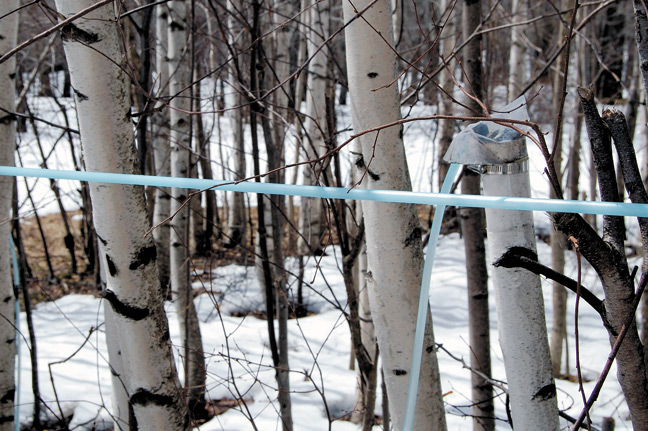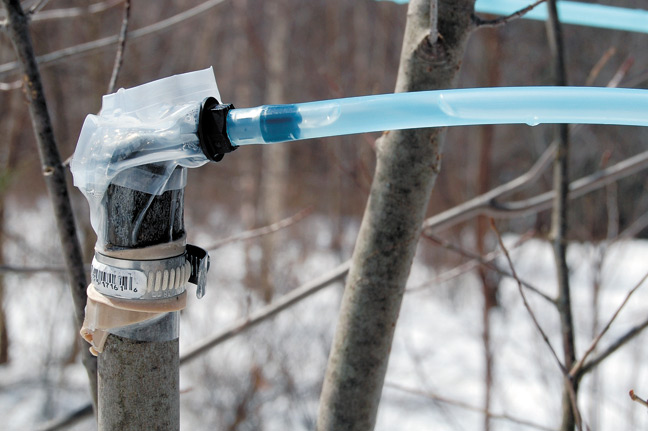Sap & Syrup
Capping the sap, plantation sugaring in Vermont
Proctor's plantation style sugaring has industry buzzing
By PETER GREGG | DECEMBER 2016
UNDERHILL CENTER, Vt.—Some people are calling it Frankenmaple.
The new plantation style sugaring system developed by the University of Vermont Proctor Maple Research Center has had the industry abuzz since it was first unveiled three years ago.
Dr. Timothy Perkins and Research Scientist Abby Van den Berg have also been giving presentations about the new technology at maple schools and an update was published this fall online here.
Expect more research results of this new method of sugaring, including research into capping existing stands of tree saplings in forests.
“We're exploring potential future research projects in this area,” Van den Berg told The Maple News on Friday.
In part of that new area of research Perkins and Van den Berg found that sap collection from small-diameter trees in regenerating stands could be combined with thinning to promote the development of crop trees, however the sap yields may be relatively low, and resprouting would ultimately be limited by the amount of available light, they reported.
“Whether the economics of implementing this practice would be favorable would largely depend on the specific circumstances of each individual situation, including the number of trees per acre available for sap collection, the availability of existing tubing systems in the area, and the costs of thinning,” Perkins said.
The industry reaction to the technology has been one of much curiosity but also fear.
Some folks claim the system could lead to huge swaths of sugar maple saplings being planted in the fertile farmlands of Iowa or, scarier yet, China. And then, the naysayers say, watch the syrup price drop.
Not to worry, say Proctor researchers.
"The whole sci-fi doom and gloom scenario is just not the case," said Van den Berg during a tour of the two plantations at Proctor given to The Maple News.
"This is going to be a way for someone with limitations of expansion to get extra production," she said, adding that the geography of production would not likely shift beyond the current Maple Belt.
Van den Berg says that the ideal use for this new type of production is for a sugarmaker who may have some open land next to their existing sugarbush. She said she does not expect sugarmakers to clear out forests to make way for a plantation. The economics just don't work that way.
Conventional sugaring will continue to be the much more economical and profitable method, according to Van den Berg.
What this new plantation style sugaring can do is supplement sugarmakers' income by allowing them to get production out of cleared land they may have.
"It's a way for someone with a couple of acres of open land to add some extra production and see returns within their lifetime," she said.
Van den Berg says that anyone planting a new plantation of saplings could except to see production within 7 to 10 years. Sugar maples work best but significant production also comes from red maples and also birch trees.
"It works really well with birch," she said.
The technology development began in 2010 when Van den Berg and Perkins both came to the conclusion that sap was being pulled through the root systems in the ground and moving upward through the tree like a straw.
"The lightbulb went off," Van den Berg said. "We cut the top off the stem of a small tree and low and behold it worked."
Van den Berg said that the ideal size of the tree for plantation production is about 2 inches in diameter and that it helps if the tree has multiple stems. Sugarmakers would then lop off alternating stems from year to year. Shoots then sprout out of the cuts during the growing season, generating tree sugars through photosynthesis just like mature trees. The sugarmaker would cut further and further down toward the base of the tree with coppice cuts, she said.
Van den Berg said that the sugar content of sap from the saplings were going as high as 3 or 4 percent on some days during Proctor's sugaring season.
But the volume of sap is very low compared to mature trees. Each sapling generates enough sap per season to give only .07 gals of syrup.
The math improves when a sugarmaker plants 5,800 saplings per acre, which is what Proctor recommends. The acreage total is similar to planting density on willow plantations for biomass production, Van den Berg said.
Sugarmakers could then expect upwards of 400 gallons of syrup per acre, she said. Traditional sugarbushes give on average of 80 gallons per acre.
During the tour for the Maple News during a recent sugaring season there was sap clearly coming through the makeshift cap tap that Proctor has developed to capture sap from the stem. It was remarkable to see.
"It's just trucking out sap," she said.
Van den Berg then meticulously tested brix levels and sap collection amounts from each sapling in collection vacuum tubes at the base of the plantation.
Proctor is hoping one of the equipment manufacturers will develop a cap that will more effectively collect from the saplings. For now Proctor uses a plastic baggie secured with a metal hose clamp. A plastic ring is used to connect standard 5/16 tubing to the cap.
"We are hand making all of this," Van den Berg said. "You make what you need from what you have."
The big lingering question is when can sugarmakers expect to start utilizing this technology.
Van den Berg said that more research and more funding is needed to develop the technology further and doesn't recommend that sugarmakers jump right into it.
"If it were me, I'd like to see more research on optimal plantation conditions," she said. I would recommend waiting."
But she acknowledges that some sugarmakers may not be able to resist.
Forrest Keeling Nursery in Elsbury, Missouri is the nursery supplier of Cornell's 'Super Sweet' Sugar Maple from the University's Sugar Maple Improvement Program.
So far there is no mass production of sap caps by equipment dealers, but sugarmakers should make it known they want one.
"If anyone is interested in doing this they should contact their dealer," she said.















